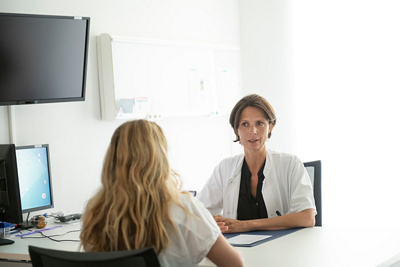The first stage of management consists of a medical examination accompanied by additional examinations that will make it possible to make an accurate diagnosis.
Medical examination
This is a consultation with a gynecologist who evaluates the patient's medical and family history as well as her current symptoms. During this consultation, the gynecologist also performs a breast examination to clarify the nature of any lump (e.g. size, location, mobility, appearance of the skin) as well as palpation of the lymph nodes.
Radiological examinations
Mammography
This is an X-ray examination of the breasts. The Geneva Breast Centre has state-of-the-art equipment in this area.
Mammography is offered as part of organized screening. It is offered to patients aged between 50 and 74 years every 2 years. Most women followed by their gynaecologist receive individual screening before age 50 and after age 74. The latter being adapted to the personal risks of each. Patients with an identified genetic risk benefit from special follow-up. Mammography may also be indicated for diagnosis in case of discovery of an abnormality by the patient or by her doctor (lump, discharge from the nipple, pain or redness of the skin, etc.).
Ultrasound
Ultrasound is an examination using ultrasound. There is therefore no irradiation. Performed with a probe, this examination is painless. A complementary ultrasound is often performed following a mammogram. This examination also helps guide a possible sample (biopsy).
Magnetic resonance imaging (MRI)
This is a non-irradiating radiological examination that offers 2D or 3D images.
Breast MRI is a second-line examination performed when the interpretation of mammographic and ultrasound images is not sufficiently satisfactory. In addition, MRI is also performed almost systematically before surgical treatment.
Needle biopsy or puncture
This examination consists of removing and analyzing a little tissue located at the suspicious site to confirm the diagnosis and clarify the nature of the lesion. It makes it possible to conclude whether or not cancer is present. All biopsies are done under local anesthesia.

